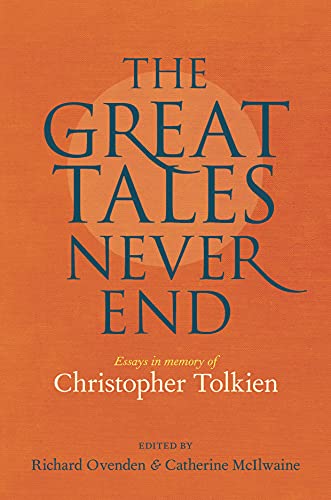Black and White Ogre Country Review
 Reviewed by Jason Fisher
Reviewed by Jason Fisher
Tolkien, Hilary. Black &
White Ogre Country: The Lost Tales of Hilary Tolkien. Ed. Angie
Gardner. Illus. Jef Murray. Moreton-in-Marsh, U.K.: ADC Publications
Ltd, 2009. Hardcover, vii + 73 pp.
It’s best to judge Black &
White Ogre Country not by its length but by its charm, a quality
suffusing nearly every one of the volume’s eighty of so pages. The
bulk of this slim book transcribes a notebook of the reminiscences of
Hilary Tolkien, younger brother of J. R. R. Tolkien. In the notebook,
he recorded — years later, “after World War II” (iv) — childhood
stories of a fictionalized but semi-autobiographical nature. Hilary’s
notebook lay forgotten for many years, but it was recently unearthed
in an attic by his grandson, Chris, the son of Hilary’s eldest child,
Gabriel. Ironically, a grandson of Ronald (J. R. R.) Tolkien
— Simon, the eldest son of Christopher Tolkien — has also been in
the news recently with the publication of his second novel. But lest
this review devolve into a hobbit-like discussion of “the small doings
of their fathers, grandfathers, and great-grandfathers, and remoter
cousins to the ninth degree”, let me move on.
The book consists of three parts.
First, a short introduction establishes the context for Black &
White Ogre Country and gives some idea of the provenance of Hilary’s
notebook. This section includes reproductions of the front and back
of the notebook as well as one of its internal pages, on which the author
sketched the two titular ogres. Angie Gardner’s acknowledgements,
it deserves mention, are accompanied by a wonderful photograph of the
young Ronald and Hilary. It was evidently taken at the same time as
the photograph in The Tolkien Family Album (21), as the two children
are dressed alike. In the photo previously published, Hilary holds a
ball; however, in the photo accompanying Black & White Ogre Country,
Ronald holds a doll and Hilary what looks like a toy dog. A long foreshadowing
of Tom Bombadil and Roverandom, perhaps.
The second, and largest, section
of the book consists of Hilary’s stories, transcribed by the editor
and beautifully illustrated by Jef Murry. This fictionalized semi-autobiography
of Hilary’s early years comprises three parts. These are titled differently,
depending on where you look. The table of contents indicates the stories
are: (i) “Bumble Dell: Black & White Ogres”, (ii) “Black &
White Witches”, and (iii) “Other Stories”. Internally, the first
story is simply called “Bumble Dell”. The front and back of Hilary’s
autograph notebook each show variations in each, including “Black
& White Witch” (singular).
The stories are quite charming in
their way, particularly for how they nostalgically recall the penultimate
fin de siècle — a time when the countryside was still unspoiled
and peopled with colorful local characters who would “pinch your shoes”
(2), when one had to walk miles out of the way for fresh milk (38),
and when the great railroads had not yet yielded up the hills
and dales to the first motorcars (then only just appearing). It was
a time, moreover, when the imaginations of children could turn the nearby
farmers and villagers into ogres, witches, and ghosts.
The final part of the book, the
back matter, consists of a reproduction of Hilary Tolkien’s signature,
a short glossary of the topical references and Arcadian vocabulary salted
into the stories, and a brief biographical sketch of Hilary. All these
are valuable, the last most of all. The sketch includes salient and
judiciously selected details, accompanied by photographs, paintings,
and letters — including an extract from a previously unpublished letter
by J. R. R. Tolkien (70–1).
Black & White Ogre Country
is not a scholarly book. It would be unfair to fault its editor for
any missed opportunities along such lines, particularly when she, with
Neil Holford, is preparing a bona fide biography of Hilary Tolkien (due
this summer). However, for such a short book, there is ample grist for
the milling. To give just one example: “bumble”, Hilary’s word
for the great blackberries that grew in the wooded hollow the Tolkien
brothers called “Bumble Dell” (4). It seems likely to me that this
geographical “bumble” is related to J. R. R. Tolkien’s Bimble
Bay. In Hilary’s case, Bumble Dell reflects an idealized corner of
England, to which he desperately clung by an act of memory alone; in
Ronald’s case, Bimble Bay represented the loss of the same,
due to “progress” (so-called). J. R. R. Tolkien’s Glip, a forerunning
of Gollum, may share some imaginative roots with the boys’ Black Ogre
of Sarehole. His “Old Crabbier” (earlier, “Poor Old Grabbler”)
may do likewise, but the poem remains unpublished.
In sum, this short but delightful book is well worth reading. It will take you no more than an afternoon, but I can think of few better ways to while away the time than by returning, however briefly, to a simpler time of “less noise and more green”, when the path to the local blackberry patch led straight through the territory of wild ogres.
Find Black & White Ogre Country at Rowns.com - Tolkien bookseller








 110
110 16708
16708